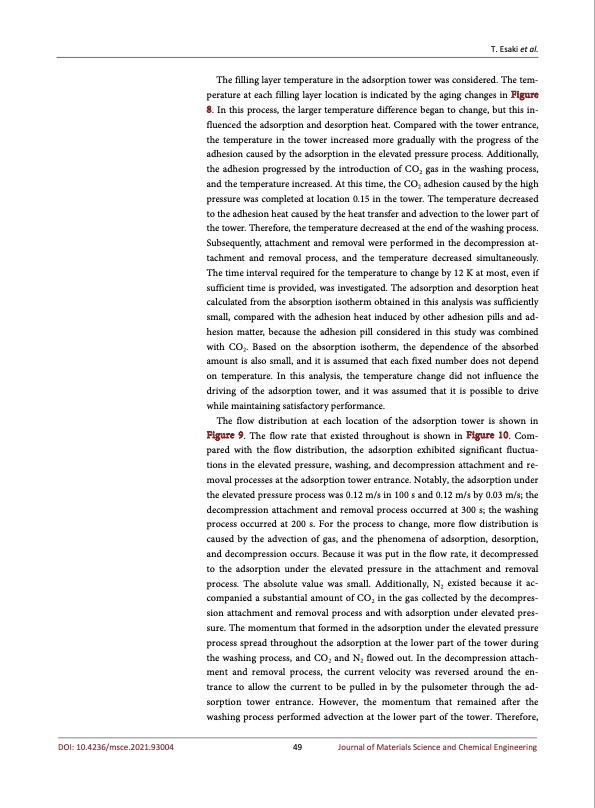
PDF Publication Title:
Text from PDF Page: 011
T. Esaki et al. The filling layer temperature in the adsorption tower was considered. The tem- perature at each filling layer location is indicated by the aging changes in Figure 8. In this process, the larger temperature difference began to change, but this in- fluenced the adsorption and desorption heat. Compared with the tower entrance, the temperature in the tower increased more gradually with the progress of the adhesion caused by the adsorption in the elevated pressure process. Additionally, the adhesion progressed by the introduction of CO2 gas in the washing process, and the temperature increased. At this time, the CO2 adhesion caused by the high pressure was completed at location 0.15 in the tower. The temperature decreased to the adhesion heat caused by the heat transfer and advection to the lower part of the tower. Therefore, the temperature decreased at the end of the washing process. Subsequently, attachment and removal were performed in the decompression at- tachment and removal process, and the temperature decreased simultaneously. The time interval required for the temperature to change by 12 K at most, even if sufficient time is provided, was investigated. The adsorption and desorption heat calculated from the absorption isotherm obtained in this analysis was sufficiently small, compared with the adhesion heat induced by other adhesion pills and ad- hesion matter, because the adhesion pill considered in this study was combined with CO2. Based on the absorption isotherm, the dependence of the absorbed amount is also small, and it is assumed that each fixed number does not depend on temperature. In this analysis, the temperature change did not influence the driving of the adsorption tower, and it was assumed that it is possible to drive while maintaining satisfactory performance. The flow distribution at each location of the adsorption tower is shown in Figure 9. The flow rate that existed throughout is shown in Figure 10. Com- pared with the flow distribution, the adsorption exhibited significant fluctua- tions in the elevated pressure, washing, and decompression attachment and re- moval processes at the adsorption tower entrance. Notably, the adsorption under the elevated pressure process was 0.12 m/s in 100 s and 0.12 m/s by 0.03 m/s; the decompression attachment and removal process occurred at 300 s; the washing process occurred at 200 s. For the process to change, more flow distribution is caused by the advection of gas, and the phenomena of adsorption, desorption, and decompression occurs. Because it was put in the flow rate, it decompressed to the adsorption under the elevated pressure in the attachment and removal process. The absolute value was small. Additionally, N2 existed because it ac- companied a substantial amount of CO2 in the gas collected by the decompres- sion attachment and removal process and with adsorption under elevated pres- sure. The momentum that formed in the adsorption under the elevated pressure process spread throughout the adsorption at the lower part of the tower during the washing process, and CO2 and N2 flowed out. In the decompression attach- ment and removal process, the current velocity was reversed around the en- trance to allow the current to be pulled in by the pulsometer through the ad- sorption tower entrance. However, the momentum that remained after the washing process performed advection at the lower part of the tower. Therefore, DOI: 10.4236/msce.2021.93004 49 Journal of Materials Science and Chemical EngineeringPDF Image | Analysis of CO2 Pressure Swing Adsorption

PDF Search Title:
Analysis of CO2 Pressure Swing AdsorptionOriginal File Name Searched:
msce_2021033014050895.pdfDIY PDF Search: Google It | Yahoo | Bing
CO2 Organic Rankine Cycle Experimenter Platform The supercritical CO2 phase change system is both a heat pump and organic rankine cycle which can be used for those purposes and as a supercritical extractor for advanced subcritical and supercritical extraction technology. Uses include producing nanoparticles, precious metal CO2 extraction, lithium battery recycling, and other applications... More Info
Heat Pumps CO2 ORC Heat Pump System Platform More Info
| CONTACT TEL: 608-238-6001 Email: greg@infinityturbine.com | RSS | AMP |